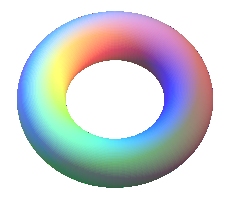| surface suivante | surface précédente | courbes 2D | courbes 3D | surfaces | fractals | polyèdres |
TIGHT SURFACE
| Surfaces studied by |
An orientable closed
surface is said to be tight if its total absolute Gauss curvature
is minimal among the surfaces of the same genus
(this total curvature being defined by
where
is the Gauss curvature, product of the principal curvatures).
This minimal value is given by the formula
where g is the genus of the surface
and
its Euler-Poincaré
characteristic.
The inequality
with equality if the surface is tense, is to be compared with the equality
of Gauss-Bonnet:
.
The following beautiful theorem concretely characterizes tight surfaces [Kühnel, p. 186] :
For a closed orientable surface S, noting
the portion of S having a positive Gauss curvature, the following
conditions are equivalent:
a) S is tight.
b)
c)
d) Any plane separates S into two or less connected
components.
In particular the 0-genus tight surfaces are the boundary
surfaces of the convex bodies of .
| Geometric tori are tight
surfaces, because any plane separates them into two or less parts, or because |
This 2-genus surface is not tight. | This 2-genus surface proposed by Banchoff and Kuiper
in 1981 is tight (see [Kühnel,
p. 186]).
It is a component of the surface of equation |
 |
 |
 |
| surface suivante | surface précédente | courbes 2D | courbes 3D | surfaces | fractals | polyèdres |
© Robert FERRÉOL 2019